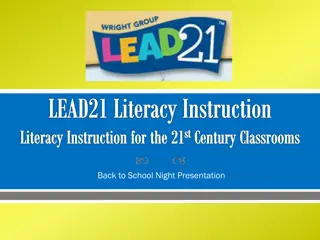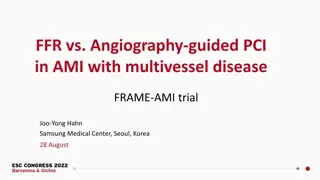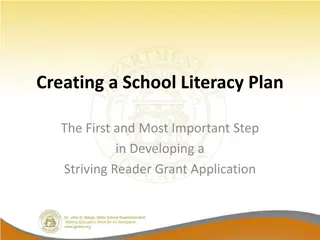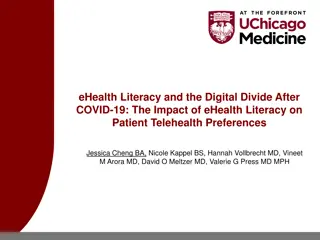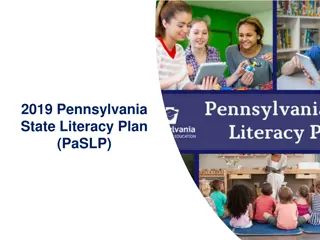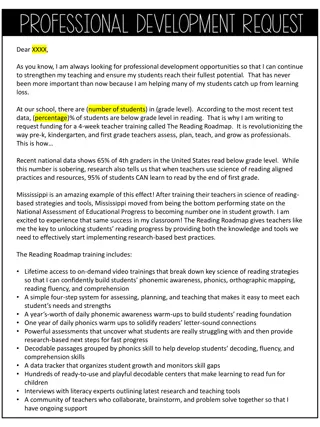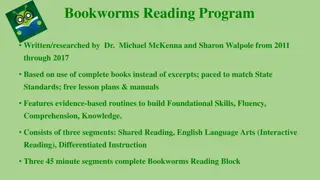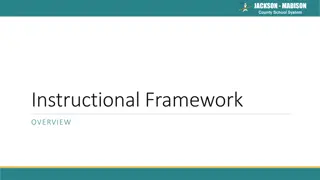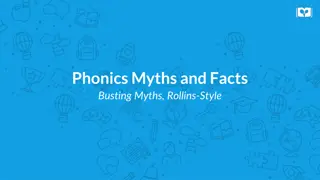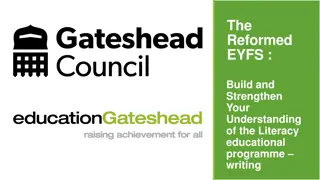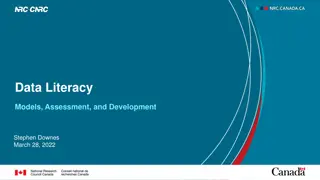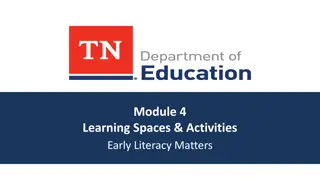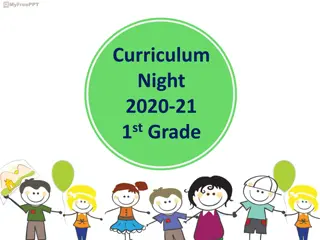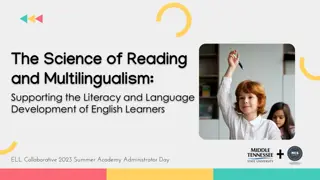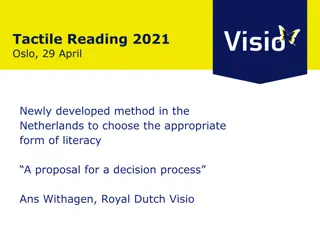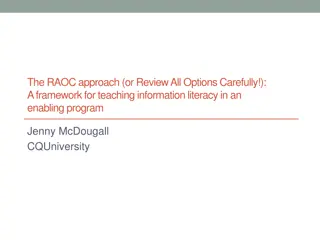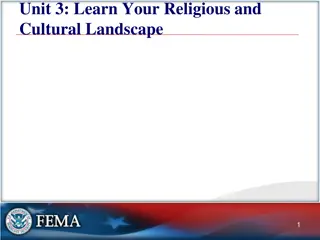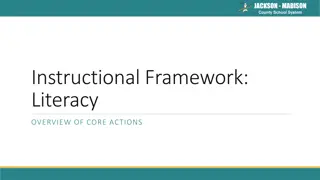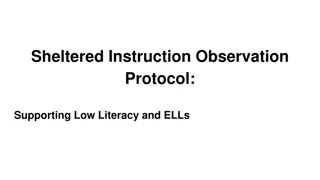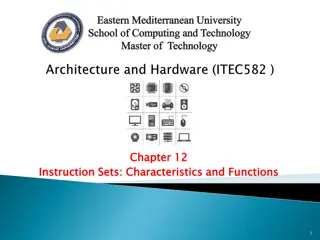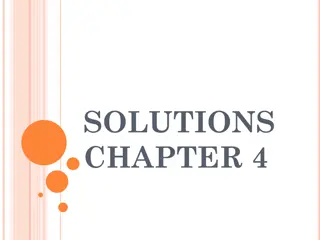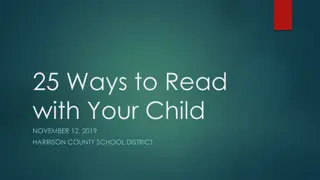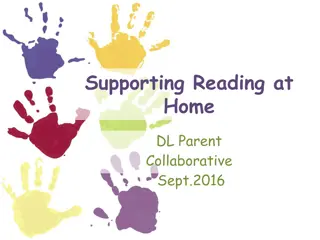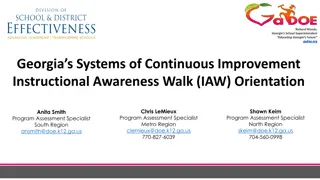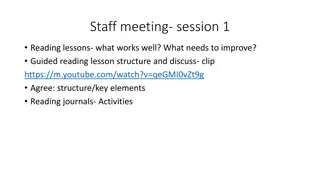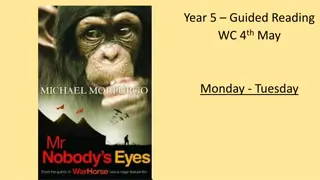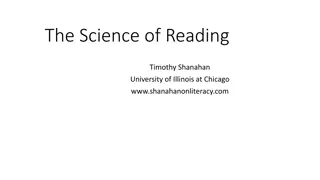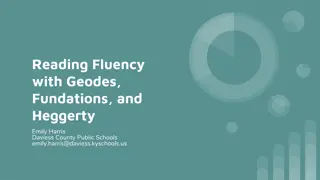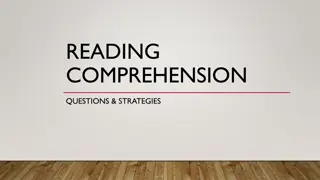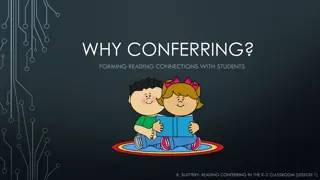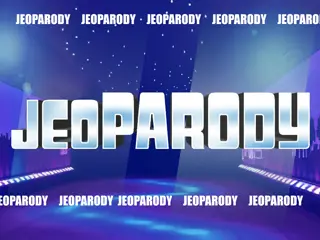Understanding Guided Reading in Literacy Instruction
In literacy instruction, Guided Reading, as highlighted by Fountas and Pinnell, involves small group sessions where teachers facilitate students' application of reading strategies in appropriate leveled texts. The focus is on individualized support, strategic problem-solving, and skill development across various reading aspects. This method is adaptable for different grade levels, emphasizing comprehension and fluency through dynamic, student-centered approaches within a flexible group setting.
Download Presentation

Please find below an Image/Link to download the presentation.
The content on the website is provided AS IS for your information and personal use only. It may not be sold, licensed, or shared on other websites without obtaining consent from the author. Download presentation by click this link. If you encounter any issues during the download, it is possible that the publisher has removed the file from their server.
E N D
Presentation Transcript
Differentiation Through Wendy Phillips , M.S., Literacy Specialist Coordinator of Reading Virginia Department of Education s Training & Technical Assistance Center (T/TAC) @ Virginia Tech
The ultimate goal of reading is to make meaning of what we have read. Comprehending text involves a complex process of intertwining skills as visually demonstrated through Scarborough s Reading Rope (2001).
As outlined in the work of Fountas and Pinnell, Guided Reading is a context in which a teacher supports each reader s development of effective strategies for processing novel texts at increasingly challenging levels of difficulty (Fountas & Pinnell, 1996, p. 3)
Guided Reading Is... Teacher works with 2-6 students in a small group. Children are grouped according to similarities in reading development and or instructional reading levels Teacher introduces stories, strategies, and concepts within the group to increase independent application in appropriate leveled text. Every child reads and is supported by the teacher. (NOT ROUND ROBIN) Emphasis is on strategic problem solving It can be adapted for any grade.
Teacher selects books Groups are dynamic; they change in response to assessment; they are flexible and fluid Teachers teach word solving, searching for & adjusting information, self- monitoring and correcting, summarizing, maintaining fluency, adjusting for purpose & genre, predicting, making connections, synthesizing, inferring, analyzing and critiquing Pinnell & Fountas, 2008) Teacher uses explicit instruction of reading strategies Teacher incorporates explicit vocabulary instruction, phonics & word work
Guiding Reading is NOT A complete reading program Consistent use of basal text Whole group instruction Writing vocabulary definitions Writing without purpose Round robin reading/Popcorn reading Sustained silent reading Just for young children
https://www.teachingchannel.org/vid eos/guided-reading-introduction#
Turn & Talk How does Jenna model expectations for workstations? How do students transition among tasks?
Elements of Guided Reading Form small group Identify emphases Select a Text Analyze the text Introduce the text Support student s reading of text Guide discussion Engage in specific teaching for processing strategies Support student s work with letters & words Extend understanding through writing about reading
Essentials of Guided Reading: 1. Small dynamic groups (using systematic assessment) 2. Instructional leveled texts & targeted teaching 3. Literacy Stations (small group management)
1.Small Dynamic Groups Size of each group: 1-3 lowest readers, 3-5 for struggling readers and 5-7 for highest readers
Grouping Placement is flexible and fluid, adapting to student s needs; teachers must continuously diagnose needs through observations Groups can be formed by strategy need or reading level (using STAR, PALS, running records,etc.)
Running records will inform not only the selection of an appropriate text but the specific emphases to prioritize for your students. #FPLiteracy
Levels Independent: 95-100% Instructional: 90-94% Frustration: Below 90% Self correction goal 1:1- 1:3
Level L-M L- Lexis L- Casey M- Kameron S. M- Tyler M- Kiara Level I, J, K J- Julietta J- Aklexia K- Adam K- Cameron Level N (M) Cheyanne Zach Jacob B. Logan Jacob L. Brittany Level N-O Adrianna Lilly Linda William Brady Zach L. Level Q Ben W. Christina Joey Adam W. Harbal Jenna Level O-P Courtney Darius Carli Sully Isaiah T.J. Level S S- Joe D. S- DJ S- Riley S- Haley S- Eva S- Rigil Level T-X T- Beau U- Megan V- Rishi W- Abby X- Tim
Reading Tracker Sheets
2. Instructional Leveled Text Basal Readers (high, medium, low) A-Z Readers Scholastic Readers F&P Readers Etc.
Targeted Teaching Prompting Guide Jan Richardson Book Prompting Guide Literacy Continuum Reading Strategies
A typical structure of a Guided Reading lesson Selecting the text Introducing the text Reading the text Discussing the text Teaching for strategic activities Extending meaning (optional) Word Work (optional) A typical Guided Reading lesson occurs as students read text that has been selected to be at an appropriate level of difficulty
Before Picture walk Conversation Genre Set purpose Preview vocabulary Build prior knowledge Connect to text with reread Make predictions Anticipation guide, KWL, thinking map
During Focus on Comprehension strategy while students read/reread text Choral Echo Partner Independent (NOT ROUND ROBIN) CAFE (Comprehension, Accuracy, Fluency & Expanding Vocabulary)
After Graphic Organizers Storyboarding Summarize Questioning Discussion Independent reading Extend learning Act our story Draw or write a response
3. Literacy Stations Listening Station Writing Station Word Study Station Classroom Library Station Technology Station Guided Reading
Answer these questions in your booklet 1. What resources are currently available? 2. What resources do you need?
Digital Access to Text ReadWorks, Newslea, TweenTribune
Intermediate/Middle Grades Many activities can be adapted for intermediate scholars! Students should be reading self- selected books and writing about them while the teacher does guided reading
A reading notebook is a tool for monitoring and assessing independent reading and guided reading Independent Reading Record Independent Reading Response (one page response) Guided Reading Notes (summaries, graphic organizers, strategy focus) New Word List (2 columns with new vocabulary word and synonym)
Readers Notebook Engaging in critical thinking Learning how to interpret a text Making connections between texts/genres Connecting reading and writing Promoting active discussion Continually responding and reflecting on a text Examining the writer s craft Not for red ink corrections
Readers Workshop Structure 5-10 minutes Book Talks & Minilessons Students: Teacher: Independent Reading Guided Reading Groups (20-25 minutes each) Writing in Reader s Notebooks Book Clubs (20 minutes each) Individual Conferences (3-5 minutes each) 50-60 minutes 5 minutes Group Share Students must have choice during independent reading
Richardson, J. (2016). The next step forward in guided reading: an assess-decide-guide framework for supporting every reader. New York, NY: Scholastic
According to the National Institute of Literacy For middle and high school teachers, the use of guided oral reading in classes limited to an hour or less of instructional time requires that teachers target a small group of their most struggling readers and alternate working with one or two of them daily during those times when other students are engaged in group or individual work. Guided oral reading involves: 1. Asking individual students to read aloud, 2. Guiding them to self-correct when they mispronounce words, and 3. Asking questions about content to ensure comprehension. https://lincs.ed.gov/publications/pdf/adolescent_literacy07.pdf
Obvious truth about reading instruction is that students learn to read by reading they learn to read well by reading w/proficiency every day #FPLiteracy
Resources: http://www.janrichardsonguidedreading.com/video-clips http://www.lesley.edu/guided-reading/#components http://www.readwritethink.org/professional-development/strategy-guides/using-guided-reading-develop- 30816.html#research-basis http://education.ucf.edu/mirc/Research/Balanced%20Reading.pdf http://mnps2010.wikispaces.com/file/view/Balanced+Literacy+Reference+Guide+2012.pdf Pinnell, G.S., & Fountas, I.C. (2010). Research base for guided reading as an instructional approach (White paper). Scholastic.





